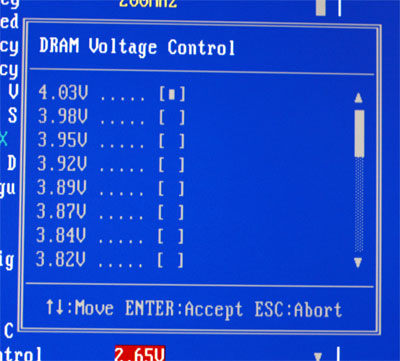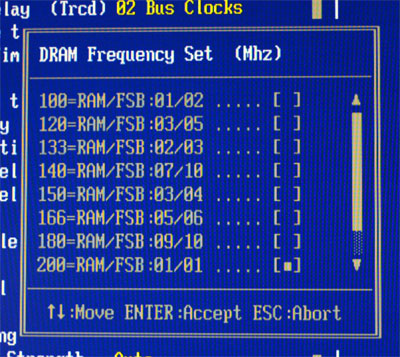DFI LANParty UT RDX200: ATI’s Crossfire AMD for the Bleeding Edge
by Wesley Fink on October 18, 2005 11:03 AM EST- Posted in
- Motherboards
Basic Features: DFI LANParty UT RDX200
The DFI nForce4 Ultra and SLI boards quickly developed a reputation for offering the enthusiast every imaginable BIOS option. The DFI RDX200 goes even further.
Oskar Wu, the Engineer behind DFI's legendary nForce4 series, is also the designer of this DFI RDX200. With so much already available in ATI's Reference design, Oskar concentrated on adding the "impossible" option of running 4DS DIMMs at 1T Command Rate and a working CAS 1.5 option in BIOS.
| DFI LANParty UT RDX200 | |
| CPU Interface | Socket 939 Athlon 64 |
| Chipset | ATI RD480 Northbridge - ATI SB450 Southbridge |
| Bus Speeds | 200 to 500MHz in 1MHz Increments |
| Memory Speeds | DDR200, 240, 266, 280, 300, 333, 360, 400 (433, 466, 500 with Rev. E AMD) |
| PCIe Speeds | Fixed |
| PCI/AGP | Fixed at 33/66 |
| Core Voltage | Auto, 0.8V to 1.55V in 0.025V increments PLUS 0.0V to 0.56V in 0.02V increments (Maximum vCore 2.11V) |
| CPU Clock Multiplier | 4x-25x in 0.5X increments |
| DRAM Voltage | Auto, 2.5V to 4.03V in .02V to .05V increments |
| HyperTransport Frequency | 1000MHz (1GHz) |
| HyperTransport Multiplier | Auto, 1X to 5X |
| HyperTransport (LDT) Voltage | 1.2V , 1/3V , 1.4V, 1.5V |
| Xpress 200 (NB) Voltage | 1.2V, 1/3V, 1.4V, 1.5V |
| NB Analog 1.2 Voltage | 1.2V, 1/3V, 1.4V, 1.5V |
| SB PCIe 1.8 Voltage | 1.8V, 1.9V |
| Memory Slots | Four 184-pin DDR DIMM Slots Dual-Channel Configuration Regular Unbuffered Memory to 4GB Total SUPPORTS 4 DS DIMMS AT 1T |
| Expansion Slots | 2 PCIe x16 1 PCIe x1 3 PCI Slots |
| Onboard SATA/RAID | 4 SATA Drives by SB450 (RAID 0, 1, JBOD) PLUS 4 SATA Drives by Sil 3114 |
| Onboard IDE/IDE RAID | Two Standard ATA133/100/66 (4 drives) |
| Onboard USB 2.0/IEEE-1394 | 8 USB 2.0 ports supported by SB450 2 1394 Firewire by VIA VT6307 |
| Onboard LAN | 2 Gigabit Ethernet PCIe Ethernet by Marvel 88E8053 PCI Ethernet by Marvel 88E8001 |
| Onboard Audio | Azalia HD Audio by Karajan Module with Realtek ALC882 Codec |
| BIOS Revision | Award (7/28/2005) |
The DFI nForce4 Ultra and SLI boards quickly developed a reputation for offering the enthusiast every imaginable BIOS option. The DFI RDX200 goes even further.


Oskar Wu, the Engineer behind DFI's legendary nForce4 series, is also the designer of this DFI RDX200. With so much already available in ATI's Reference design, Oskar concentrated on adding the "impossible" option of running 4DS DIMMs at 1T Command Rate and a working CAS 1.5 option in BIOS.










48 Comments
View All Comments
nsk - Tuesday, October 18, 2005 - link
Having 8 SATA ports is very useful. kudos to DFI for putting that extra SiI chip.Diasper - Tuesday, October 18, 2005 - link
What's good about this board IMO is the Azalia Audio and CPU utilisation - *very* impressive for on-board audio. Performance and options are of course very good as well although nothing worth paying significantly more for.However, just to point out one additional benefit of the board that you guys might not have realised yet is that it could very much make a quiet computer guy very happy as the active chipset cooler can very easily be replaced with a passive heatsink eg Zalman one. Trying that with many NF4 is impossible unless resorting to modding - with some coming up with some quite radical solutions. After all there's no point buying a nice and expensive case like the Antec P180 and then a quiet PSU ontop only to have a screaming NB fan in your NF4 - unless resorting to modding.
However, as others have mentioned deal-breakers include poor USB performance and no SATA 2 and possibly cost althought we'll have to wait on that one.
Azkarr - Tuesday, October 18, 2005 - link
Well, it's on newegg now. $239? I think thats just about $50 too much for not having SATA II. Plus, none of the Crossfire cards except the XL are out, so I don't think there's a point to buying this board.http://www.newegg.com/Product/Product.asp?Item=N82...">Newegg
Slaimus - Tuesday, October 18, 2005 - link
Which sound driver was used to get such a low CPU usage score? Realtek or ATI?Wesley Fink - Tuesday, October 18, 2005 - link
We used the Realtek sound driver on the DFI CD with the board for testing. We did use the current 5.10 Catalyst drivers, however, instead of the Crossfire 5.8 drivers on the CD.nourdmrolNMT1 - Tuesday, October 18, 2005 - link
http://images.anandtech.com/reviews/motherboards/d...">http://images.anandtech.com/reviews/motherboards/d...WTF is up with the one SATA connector? sata7 specifically it looks completely off.
emilyek - Tuesday, October 18, 2005 - link
A clawhammer for overclocking?Also,
A real test of the 1T/2T stuff would be gaming benchmarks for 2 x 1G @ 1T and 4 x 512 @ 2T. That's the test I want to see.
ozzimark - Tuesday, October 18, 2005 - link
this stands out at me.http://images.anandtech.com/graphs/dfi%20rdx200_10...">http://images.anandtech.com/graphs/dfi%20rdx200_10...
that data is... somewhat useless for the top 5-9 boards, as it's obviously a cpu limitation. try oc'ing the htt/fsb with the fx-57 and watch the board break 400mhz
Pete84 - Tuesday, October 18, 2005 - link
Horrible!! The only things going for this board is that I. It has Crossfire and II. It has some nice memory capabilities and III. It has Azaliz.Pathetic USB performance, no SATA II!!! When even budget minded boards have SATA II and this one does not, now that is a serious lapse. Having a seperate raid controller with some SATA II ports would help this, especially so if it was on the PCI-E bus, but wow . . . and price at $230!!!
haelduksf - Tuesday, October 18, 2005 - link
I don't understand why SATA-II is such a big deal to so many people. NCQ has a negligable impact unless you're running a server (on a XFire motherboard...), and the 300MB/s transfer speed has no effect at any time with currently available harddrives.